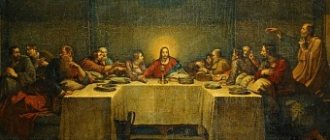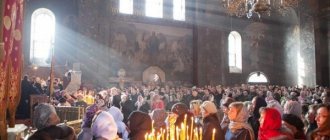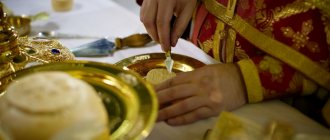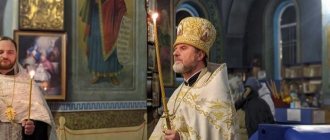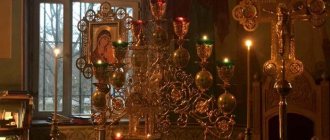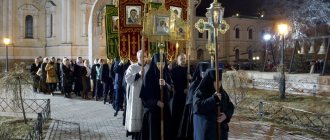"Save me, God!".
Thank you for visiting our website, before you start studying the information, please subscribe to our Orthodox community on Instagram, Lord, Save and Preserve † - https://www.instagram.com/spasi.gospodi/. The community has more than 400,000 subscribers. There are many of us like-minded people and we are growing quickly, we post prayers, sayings of saints, prayer requests, and timely post useful information about holidays and Orthodox events... Subscribe. Guardian Angel to you!
Good afternoon, brothers and sisters. We ask you to subscribe to our Orthodox page on Instagram https://www.instagram.com/spasi.gospodi/. We lead it with soul and we already have more than 400,000 subscribers. Join us. Guardian angel to you!
It is almost impossible to know all the nuances and features of sacred rites in the Orthodox faith. It is very difficult to understand all the intricacies, which will take a lot of time, effort and patience. What is proskomedia in Orthodoxy - let's figure it out together in this article.
Is mass a church service or a type of prayer?
Every Orthodox Christian knows that the main central service of worship is the Liturgy. However, when submitting a note about health or repose in church, you can hear questions: “Are you submitting for Proskomedia? Maybe order Mass? No, it’s better for you to pray,” etc. Even a churchgoer can easily become confused. Mass - what is it? Is this a prayer or part of a worship service? Is it different from the Liturgy? We will answer these questions in this article.
Orthodox Liturgy
Russian
Morphological and syntactic properties
| Wikidata has the lexeme obedenya (L135341). | ||
| case | units h. | pl. h. |
| Them. | mass | mass |
| R. | mass | lunch |
| D. | mass | mass |
| IN. | mass | mass |
| TV | poorer, poorer | mass |
| Etc. | mass | masses |
oh my bad
Noun, inanimate, feminine, 1st declension (declension type 2*a according to the classification of A. A. Zaliznyak).
Root: -lunch-; suffix: -н; ending: -i.
Pronunciation
- MFA: units h., plural. h.
Semantic properties
Meaning
- church, colloquial Russian folk name for liturgy; church service for Christians, performed in the first half of the day, that is, before lunch ◆ On a holiday, before the start of trading, in the settlement where mowers and rowers are hired, mass is usually served in the church, and everyone stands decorously and prays, listening to Father Prokop or Father Dorosha. G. P. Danilevsky, “Fugitives in Novorossiya”, 1862 (quote from the National Corpus of the Russian Language, see References) ◆ After mass, we drank tea under a canopy near the church. E. I. Chirikov, “Travel Journal”, 1849-1852 (quote from the National Corpus of the Russian Language, see References)
Synonyms
- liturgy, part: mass
Antonyms
- —
Hypernyms
- worship
Hyponyms
Related words
Etymology
Phraseologisms and stable combinations
- ruin the whole mass
Translation
List of translations
- Ukrainianuk: obіdnya
Bibliography
- To improve this article it is desirable:
- Add all semantic connections (absence can be indicated with a dash, and uncertainty can be indicated with a question symbol)
Liturgy is the basis of Christian life
“This is the axis mundi!” - this is how righteous John of Kronstadt exclaimed about the Divine Liturgy. And this is truly the most important and ancient service. Around him, like wheels around an axle, the entire liturgical cycle of Orthodoxy is built.
The main Sacrament of the Orthodox Church is performed during the Divine Liturgy. This is the Sacrament of Communion or the Eucharist. Christians eat bread and wine, which are mystically transformed during the service into the Body and Blood of Jesus Christ.
The Eucharist was instituted by the Lord Himself on the eve of His suffering on the cross. Christ gathered for the last time with his disciples in the Upper Room of Zion to celebrate the Old Testament Passover. The Savior broke the bread and distributed it to the apostles with the words:
“Take, eat, this is My Body” (Mark 14:22).
Then he handed over a cup of wine and said:
“This is My Blood of the New Testament, which is shed for many” (Mark 14:24).
And now, for two millennia, according to the covenant of Christ, believers in the Eucharist have received the Lord Himself into their body, heart and soul.
“The Liturgy is a treasury, the source of true life, because the Lord Himself is in it” (Righteous John of Kronstadt).
The Liturgy can be divided into three parts. The first - Proskomedia - occurs invisible to those praying. Behind the closed Royal Doors, the priest prepares the Holy Gifts for the Sacrament of Communion, praying for the entire Church of Christ. The Third and Ninth Hours are read in the temple at this time.
Then the curtain of the Royal Doors opens and the Liturgy of the Catechumens begins. A catechumen is a person who is not yet a member of the Church and is only preparing to receive Baptism. In ancient times, such people could be present at the service during the reading of the Gospel and the Apostle. After the litany of the catechumens, before the start of the third part of the Liturgy, they had to leave the temple. Today this tradition is almost lost due to the absence of the catechumens themselves.
Then the Liturgy of the Faithful begins. In this part of the service, the oldest main prayer is read - the Anaphora or Eucharistic Canon. It is at this moment that the main Sacrament of Orthodoxy is performed - the transformation under the influence of the Holy Spirit of bread and wine into the Body and Blood of Christ.
What is the difference between Vespers, Matins and Mass?
The evening service is dedicated to offering prayers of thanks to God for the day. During Vespers, parishioners thank the Lord for the past period of time, and also ask for help and blessings for the coming night.
During Vespers the following are held:
- Ninth hour;
- Vespers;
- Compline.
In the morning, Christians in church in their prayers express gratitude for the sleep sent down to them for rest or for the past night period, asking for help in the coming day.
Matins consists of:
- Midnight Offices;
- Matins;
- First hour.
During mass, prayers are offered to the Almighty for the living and the departed, that is, dead people. During the day's service, the Sacrament of Communion is performed.
Mass includes:
- Third hour;
- Sixth hour;
- Liturgy.
According to the time calculation that was relevant at the time of the Gospel events, at the third hour of the day Jesus was led to trial before Pontius Pilate. And at six o’clock in the afternoon the crucifixion of Christ took place, which is what the next service reminds of.
And only after this does the liturgy begin, in which there are three “acts”:
- Proskomedia;
- Liturgy of the Catechumens;
- Liturgy of the Faithful.
What is mass
Liturgy is the main divine service of the Orthodox Church. But what is Mass and how is it related to the Liturgy? These names are synonymous words.
Historically, the word Mass dates back to the times of the first Christians. They brought bread and wine with them to celebrate the Sacrament of the Eucharist. At the end of the Liturgy, a joint dinner was organized from the remaining gifts. This served as the basis for the second name.
Over time, the tradition of sharing meals after worship ceased. And among the common people, the term “Lunch” was assigned to the Liturgy according to the time at which the service is usually performed. That is, in the first half of the day, before lunch.
Righteous John of Kronstadt associated the emergence of the popular name Mass with the fact that the Liturgy is a formal dinner at which Christians are honored to partake of the Divine meal: the Body and Blood of Christ.
“Our liturgy is also called mass. This is the Dinner and Feast to which the Lord calls through His servants; servants are shepherds” (Righteous John of Kronstadt).
In addition, people often hear the following phrases: “custom mass,” “mass for health,” or “mass for repose,” etc. This is what Orthodox people call the reading of church notes by clergy during the Divine Liturgy. Such prayers are performed during Proskomedia, at a special or funeral litany. And also at the end of the Liturgy during a prayer service or memorial service (depending on whether the church note was written about health or repose).
What is the daily liturgical cycle?
The church day follows a specific schedule, which includes three important services:
- Vespers;
- Matins;
- Mass.
These are the colloquial names of the services, reflecting the time of execution of each of them. From the point of view of a person who does not know some traditions, this cycle begins in the morning, that is, with Matins. But for priests and other people working in the church, the countdown of the circle begins in the evening. As an argument for this order of events, they cite the fact that the creation of the world began in the evening.
Therefore, at the beginning of the circle there is Vespers, then comes Matins, after which comes Mass. Each of the services, in turn, is divided into three parts, resulting in nine services.
In this video, Father Afanasy explains how the daily cycle of services is conducted in the Orthodox Church:
Proskomedia - part of the mass
If you want to submit a church note, which prayer should you choose: Proskomedia or Mass? We need to figure out what Proskomedia is and how the prayers of Mass differ from it.
Proskomedia is the first preparatory part of the Liturgy. The priest takes five special prosphoras, from each of which he takes out particles for the Sacrament of Communion and places them together on a special dish called a paten.
From the first prosphora, a part is cut out in the form of a cube - the Lamb, which symbolizes Christ the Savior. It is this Lamb prosphora that believers will receive communion.
From the second “Theotokos” prosphora, a portion is taken in honor of the Blessed Virgin.
The third prosphora is called “nine-day”, since particles are taken from it in memory of the nine saints. These are John the Baptist, all the Old Testament prophets, apostles, saints, martyrs, unmercenaries (saints who renounced their property), the parents of the Mother of God Joachim and Anna, as well as Saint John Chrysostom or Basil the Great (depending on whose Liturgy is being celebrated).
The fourth prosphora serves to commemorate all living Orthodox Christians. From the fifth, the priest takes out particles in honor of all the departed.
After this, the priest begins to commemorate each Orthodox Christian whose name is indicated in the church note. For each name, he takes out a particle with the words “Remember, Lord, (name)” and places it on the paten with the previously removed particles.
“It is a great honor to remember someone’s name at the hour when the remembrance of the Terrible Sacrifice, the Terrible Sacraments takes place and the Lord Christ Himself is present” (St. John Chrysostom).
At the end of the Divine Liturgy, the priest dips the particles taken out for all the Christians indicated in the notes into the Blood of the Lord, saying the prayer:
“Wash away, Lord, the sins of those who were remembered here with Your honest Blood, with the prayers of Your saints.”
Proskomedia about health what is it
In the Orthodox faith, the most important thing during a church service is the liturgy or mass, during which the sacrament of communion is performed. To perform this ritual, you need red wine, prosphora or a slice of bread.
- The necessary components of the ritual are prepared in advance, in a special way. The priest, together with the deacon, put on sacred, elegant clothes and perform a ceremony on the altar, during which they read special prayers. It is worth noting that proskomedia are both about health and repose.
- Prosphora and red wine are required for the ceremony. It was these foods that Jesus consumed during the establishment of the sacrament. Since ancient times, to prepare sacred bread, parishioners brought various types of bread to church, from which the best were selected and used during church activities.
- The church ministers consumed the remaining baked goods during a friendly meal, which necessarily took place at the end of the liturgy.
- All parishioners of the temple were invited to the meal. People also brought oil, wine, sugar, incense and many other foodstuffs simply necessary for preparing a meal to the temple. All these gifts were called prosphora at proskomedia.
In the modern world, things are a little different. When going to church, parishioners do not take various dishes with them, and prosphora is usually called bread, which is baked by burnt priests themselves.
Note for mass - when and how it is commemorated
In different churches you can find different names for the church service associated with the Mass: “custom mass,” “mass for health,” “full commemoration.” All this implies the commemoration of names several times during the Liturgy.
The first time was during the Proskomedia - the preparatory part of the Mass. At this moment, the priest reads each name of the church note, taking out particles from special prosphoras.
Then the health notes are read during a prayer called the “extreme litany.” The word “litany” is of Greek origin and literally means “protracted prayer.” During such a prayer, the choir responds to each request of the priest “Lord, have mercy” or “Give, Lord.”
“Augmented” means intensified, since the exclamation “Lord, have mercy” is repeated three times each time. At the moment of the special litany, the priest offers a petition:
“About mercy, peace, life, health, salvation of the servants of God (name) and all those present and praying here, and to multiply the life of their lives.”
At this moment, he publicly or secretly to himself (depending on the traditions of the parish) lists the Christians whose names are indicated in the health note.
If a mass of repose is ordered, then the names from the church note are remembered during the funeral litany. One of her petitions reads:
“For the ever-memorable servants of God (name of the rivers), peace, silence, blessed memory of them, let us pray to the Lord.”
Here the names of our deceased loved ones and relatives are listed.
At the end of the Liturgy, church notes submitted for Mass are read during a prayer service for health or a funeral service.
When choosing between Proskomedia and Obedenia, you should not think that one of the prayers is stronger and more effective. There is no need to attribute magical properties to a church note. The main thing is our virtuous life in the bosom of the Church according to the commandments of Christ and sincere prayer for our loved ones.
“Our trouble is that we often limit ourselves only to the external side of commemoration: memorial services, magpies, notes, etc. And at the same time, I won’t lift a finger so that for the sake of my loved one, at least a little bit, refrain from anger, slander, condemnation , gluttony, etc.” (Professor A.I. Osipov).
Eucharist - gratitude to God
To understand what mass is, you should take a closer look at the concept of “Eucharist”. Translated from Greek, it means “gratitude”, “appreciation”, and again comes from the Greek words “good” and “honor”.
The name “Eucharist” is used in the Orthodox tradition, in the Catholic and Anglican traditions the name “Holy Communion” is accepted, and in the Protestant tradition the name “Lord’s Supper” or “Breaking of Bread” is accepted. Just like the names, in these branches of Christianity both the understanding of the essence of this sacrament and the external side of the ritual differ.
How often should memorial notes be submitted?
The prayer of the Church and the Most Holy Sacrifice attract the mercy of the Lord to us, purifying and saving us. We always, both during life and after death, need God's mercy towards us. Therefore, it is necessary to be worthy of the prayers of the Church and the offering of the sacrifice of the Holy Gifts for us or our loved ones, living and deceased, as often as possible, and necessarily on those days that have special meaning: on birthdays, baptism days, name days of both one’s own and members of your family. Honoring the memory of the saint whose name we bear, we thereby call on our patron to pray and intercede before God, because, as the Holy Scripture says, the intense prayer of a righteous person can do a lot
(). It is imperative to submit a note of remembrance on your child’s birthdays and baptisms. Mothers must carefully monitor this, because caring for the child is their sacred duty.
. Whether sin attracts us to itself, whether some passion takes possession of us, whether the devil tempts us, whether despair or inconsolable sorrow befalls us, whether trouble, need, illness have visited us - in such cases, the prayer of the Church with the offering of the Bloodless Sacrifice serves as the surest means of deliverance, strengthening and consolation.
Types of services
There is a certain classification of services - they are daily, weekly and annual. Certain liturgies are also distributed by day of the week:
- Sunday is Little Easter, when the resurrection of Jesus Christ is commemorated;
- Monday is the day of prayer to the Angels;
- Tuesday - they pray to John the Baptist;
- Wednesday - remember the Cross and the betrayal of Judas;
- Thursday is an apostolic day, dedicated to St. Nicholas;
- Friday - pray for the suffering of Christ;
- Saturday is the day of the Mother of God.
Liturgy takes place at least every Sunday
The regularity of services depends on the temple: the location where the temple is located and the number of parishioners. In other words, the Liturgy takes place in the church as often as is actually needed.
For example, in monasteries, services are held every day: since the meaning of the monastery for its monastic inhabitants is to serve God, and the Liturgy for them is not a duty, but life.
In some non-monastic churches, Liturgies may also be served daily.
In rural and small city churches, the Liturgy, as a rule, is celebrated at least once a week (on Sunday) and on major Church holidays.
A reminder for those wishing to submit a note about the living and the deceased
1. Notes must be submitted before the start of the liturgy. It is best to submit notes of remembrance in the evening or early in the morning, before the start of the service.
2. When writing down the names of the living and the dead, remember them in the process of writing with a sincere desire for their good, from the bottom of your heart, trying to remember the one whose name you are writing in - this is already a prayer
.
3. The note must contain no more than ten names. If you want to remember many of your family and friends, send a few notes. 4. Names must be written in the genitive case (answer the question “who?”). The names of bishops and priests (priests) are indicated first, and their rank is indicated - for example, “about the health” of Bishop Tikhon, Abbot Tikhon, Priest Yaroslav, then write your name, your family and friends. The same applies to notes “about the repose” - for example, Metropolitan John, Archpriest Michael, Alexandra, John, Anthony, Elijah, etc. 5. All names must be given in church writing (for example, Julia, not Yulia) and in full (for example, Alexander, Nikolai, but not Sasha, Kolya), 6. The notes do not indicate last names, patronymics, ranks and titles, degrees of relationship. 7. A child under 7 years of age can be indicated in a note as an infant - baby John.
8. If you want, in health notes you can mention “sick”, “warrior”, “travelling”, “prisoner” before the name. They don’t write in notes – “suffering”, “embarrassed”, “needy”, “lost”. 9. In the notes “On repose” the deceased is referred to as “newly deceased” within 40 days after death. It is allowed in notes “On repose” to write before the name “killed”, “warrior”, “of ever-memorable” (day of death, name day of the deceased).
Is it possible to write in notes “For health” and “For repose” of people for whom it is unknown whether they have been baptized?
The notes that are given to the altar at the proskomedia list the people for whom the Holy Church makes the Bloodless Sacrifice at the liturgy. Therefore, it is understood that all these people are not only baptized, but also recognize themselves as members of the Church. If people are baptized, but do not live the church life (), then it is more appropriate to submit notes for them for commemoration when reading the Psalter.
How to write in notes the names of people whose names are not in the calendar?
The tradition is to baptize with a name “from the church calendar”, i.e. according to the calendar, this is only a good Russian tradition, which does not exclude the commemoration of those Christians whose names do not correspond to it. There is even a special circular on this topic:
“The Moscow Patriarchate receives letters that draw attention to cases of denial of liturgical commemoration and participation in the Sacraments in relation to those Orthodox believers who are baptized in other Local Orthodox Churches (for example, in the Bulgarian, Georgian, Romanian, Serbian, Finnish, etc. etc.) with the naming of names that are not in the monthly calendar of the Russian Orthodox Church. In the traditions of some Local Churches, at baptism it is allowed to name babies with national names that are not in the church calendars. In connection with the above, with the blessing of His Holiness, His Holiness Patriarch Kirill of Moscow and All Rus', I remind you that no restrictions should be allowed in liturgical commemoration and admission to the Sacraments of the Church for believers bearing national names and baptized in other Local Orthodox Churches. I ask you to convey this information to the abbots of the monasteries and parishes of the diocese entrusted to you.”
People who have recently started going to church find it difficult to understand the meaning of church services. One of the sacred rites that raises many questions is proskomedia
. How it goes, how this ritual differs from simple prayer for loved ones, we will consider below.
Duration of church service - how long does it last?
As a rule, on Sundays, matins begin around 7-8 o'clock in the morning, vespers - 7-8 o'clock in the evening, respectively . There are also daytime liturgies, usually lasting from 3 to 6 pm. It is also possible to individually reschedule services an hour earlier or later. On weekdays, services usually last no more than two hours, Sundays – three.
It is always better to find out how long a particular service lasts on a certain day in the church itself from the ministers, since the description presented above is approximate, and each church has the right to adjust the schedule of services in its own way.

